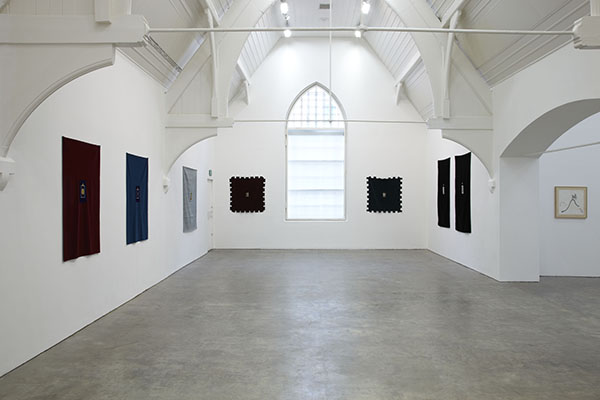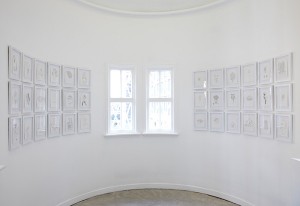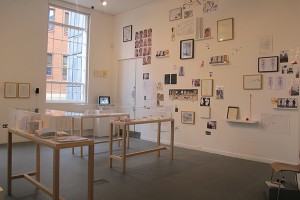In the time that I’ve lived in Birmingham there’s a place that has frequently come up in conversation/email/the twittersphere that I have never knowingly been in the vicinity of, let alone visited. Yet Ikon is one of the best regarded galleries in the region, and I finally made the trip last month to see what I had been missing out on.
Ikon Gallery began life in the mid-1960s. Founded by Angus Skene and artists from the Birmingham School of Art, the gallery was initially housed in a glass-walled kiosk in the Bullring in an attempt to offer a more open environment for those unsure about what to expect looking from the outside in. After initial success, the gallery moved and expanded, changing locations as popularity grew and existing leases expired.
Before long, Ikon had become one of the most important contemporary galleries in the country. In 1997, after a lengthy stint opposite the Alexandra theatre, the gallery moved to its current location and a building I feel is very befitting of the name.
Now based in Brindleyplace – an area that was completely rejuvenated roughly 20 years ago – Ikon lives inside the former Oozells Street Board School, designed by John Henry Chamberlain in 1887. Just around the corner from the Sea Life Centre, easy parking right next door at Brindleyplace NCP and a beautiful, beautiful building. You can certainly see why it would make a great family day out.
Without wanting to sound like a broken record from my previous articles, it’s scenery like that which Ikon Gallery is based in that makes me appreciate Birmingham all the more. A lovely, modern square – the image of what good investment can do for depleted areas of a city. Recently, Ikon revealed plans for Ikon 2 as part of the redevelopment project in the Eastside district. Having not known the city 20 years ago (I was only 7), it’s difficult for me to judge too greatly, but from the outside in it feels as though Eastside is what Brindleyplace was 20 years ago, albeit Eastside starting from a better base point. A hefty piece of investment, Birmingham’s cultural spaces continue to grow and there’s more reason to be excited about where this city is heading from an arts perspective.
It’s the topic of where Birmingham sits as a culture capital that formed the basis of my interview with Helen Stallard and Stuart Tulloch when I visited Ikon not too long ago. Helen is part of the marketing team at Ikon, whilst Stuart is the curator and has been in the role roughly 6 months. With both myself and Stuart being new to the city it led to some very interesting conversations about how Birmingham is viewed form the outside, though Stuart is much better versed than I am on the history of Birmingham’s art movements.
Before we began the interview, Helen took me on a tour of the building and through the current exhibitions on display. On the second floor, the fabric motifs of Russian artist Timur Novikov don the walls in bright rooms with high ceilings, the perfect arrangement when viewing what are relatively large scale works. The shape of the building really lends to the gallery space and you feel like you’re in a special place.
Dotted around the rooms are Visitor Assistants who help the viewer understand the artist, the artwork and the technique applied in the creation. All seem happy to do so, which may seem a given, but I actually find it very refreshing. I’ve been to a few exhibitions lately in which people in similar roles have done everything to avoid eye contact with me and sat on their phones.

Part of Ikon’s 2nd Floor Gallery
Adjacent to the Second Floor Galleries is the Tower Room. In what feels like a really unique space, a video by Angolan artist Nástio Mosquito is played. You can see the Tower Room in the pictures of the front of the Ikon building, for want of a better phrase, it’s a pretty cool room.
Below in the First Floor Gallery is the work of Neoclassical sculptor John Flaxman. In what is once again a really vibrant, clean space the artwork is fantastically positioned. It’s easy to see why the gallery is held in such high esteem.
A room I did not visit in my first experience of Ikon (but one I am sure shall become a frequent haunt for my son and I) is the Events Room, a base for Ikon’s learning programme. This part of the gallery is extremely important to Ikon, it’s a chance to engage with visitors on another level. On one hand, it promotes creativity and interaction with the art in the gallery and beyond. On the other, it enables the gallery to learn from its patrons about their experiences and further develop a programme that will continue to attract and develop relationships.
The learning programme is quite varied. From workshops based around the art on display (a good example of this would be the ‘Drawing in Stitch’ workshop on the 20th April), to walks, afternoon teas and storytelling event ‘Tell me on a Sunday the programme caters for a variety of interests and age groups. Many of the workshops are free, though occasionally you may have to pay for materials.
In sourcing artwork for exhibitions, Ikon takes its pick from emerging artists, both nationally and internationally. There will often be historical works, but these will have a significance to now. The gallery will often collaborate with other organisations in order to produce touring shows, or even exhibitions in other spaces in Birmingham, much like Metropolis currently on display in the Gas Hall at BMAG. Metropolis has been collected by Birmingham Museum and Art Gallery and the New Art Gallery Walsall in partnership with Ikon. I went last weekend and it’s a great exhibition. For someone with a real affinity for large cities like myself I found it a visual feast. It’s on until the 23rd of June so plenty of time to make a visit if you haven’t already.
The exhibitions at Brindleyplace mentioned above finish on the 21st of April, so if you are intrigued then head over soon before it’s too late. A typical cycle between a gallery refresh is 7 weeks, with a brief break in between to install the new exhibition. In this instance, the new galleries will be open from the 1st of May and include work by François Morellet and Giorgio Sadotti.
It’s now 15 years since Ikon moved to Brindleyplace, and next year marks the 50th anniversary of the gallery’s conception. In the programme over 2014 you can expect to see reflections on some of the significant artists they’ve had in the gallery over the past half a century. From my point of view it’s going be very interesting to revisit how the gallery was founded. It clearly has a big part to play in what Birmingham has to offer the arts community in the future, much like it has done for the past 50 years.
You can find out more about Ikon Gallery’s events, programme and history at their website www.ikon-gallery.co.uk
What are you experiences of the gallery? Please comment below and share with us what you have enjoyed over the years.



I’ve been to the Ikon on a number of occasions it’s very interesting. I really enjoyed Tell Me On A Sunday. A captivating story telling event that can often be poignant and amusing.